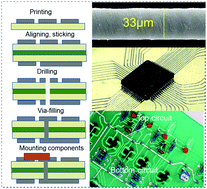Fast fabrication of double-layer printed circuits using bismuth-based low-melting alloy beads†
Abstract
Low-melting metals are newly emerging functional materials with rather unique physical or chemical properties. This paper introduces a novel way of fast fabricating double-layer printed circuits using bismuth-based low-melting alloy beads. BiInSn printed lines solidify immediately when deposited on a substrate at room temperature, so no additional post-treatment is required after printing. Thus, the method saves the fabrication time of the printed circuits. The implementation of a double-layer circuit based on the BiInSn alloy is rapidly executed in turn by printing, aligning, bonding, drilling, and via-filling. In particular, the via-filling process can be carried out by directly injecting a molten BiInSn alloy under differential pressure. In this way, the connection between the vias and the printed lines devastatingly fits with the same printing material. The minimum width of the printed line can achieve 33 μm, resulting in the highest resolution printing technique to date with a bismuth-based alloy. This new method offers more simplicity, practicability, and functional diversity in electronic fabrication and benefits to efficiently realize stable double-layer circuit boards with more straightforward steps. Therefore, it has the potential to promote the development and application of low-melting metals in the field of printed electronics.



 Please wait while we load your content...
Please wait while we load your content...